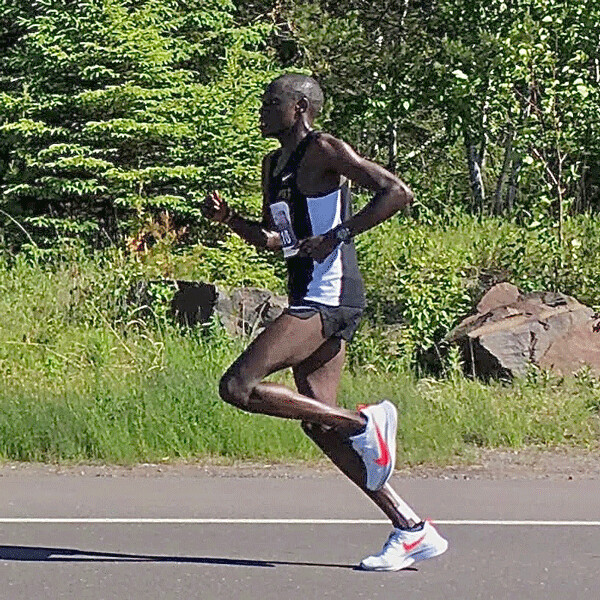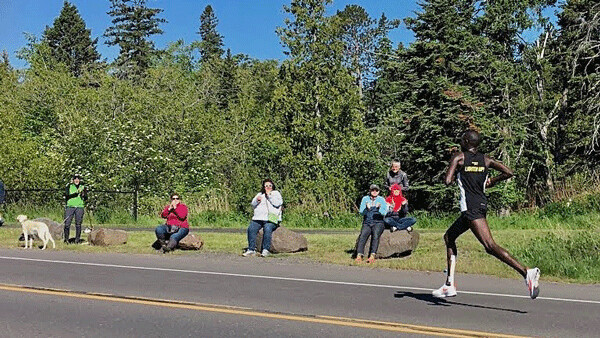Grandma’s Marathon Good for More Surprises

Conditions were definitely conducive to record times at last weekend’s Grandma’s Marathon, which again lived up to its billing as a prime U.S. marathon run for all who are interested.
The preface hype quite logically was centered on Kenyans Elisha Barno, who had strung together victories in the last four Grandma’s runs along the North Shore. Before Barno showed up, his countryman Dominic Ondoro, who had set the race record five years ago, the year before Barno showed up, and the two figured to be battling for victory again.
It didn’t happen. In fact, two first-time entries at Grandma’s took home the victories, Boniface Kongin in the men’s and Nell Rojas in the women’s. Both ran away to substantial leads, and won, but by different means.
Kongin, 29, is also from Kenya, but hadn’t run Grandma’s before. He had run, and won, the Pittsburgh Marathon less than two months earlier, and while most runners wouldn’t enter another marathon so soon, Kongin entered and then blistered the North Shore course at a record pace, while Barno and Ondoro failed to finish in the top 10, and Ondoro dropped out.
Kongin ran into plenty of problems in the last eight miles of the 26.2-mile run, and had to stop and walk at several points. He barely made it across the finish line, suffering from problems with his left hamstring and his right Achilles tendon. Despite slowing down, Kongin won in 2:11:56 — almost three minutes off Ondoro’s record time. But that was nothing like the pace that had him flying through the first 19 miles that calculated to be in the 2:06 area and surely under the record.
Kongin had met a family from Duluth while the last two months with a West Duluth family he’d met last year at the Twin Cities Marathon, to help their son train. He looks taller than 6-feet, because of his long, slim legs that seemed to carry him at a swift, smooth glide as he ran away from the field. He won by only 20 seconds over Andrew Colley, to the surprise of the field of elite runners and all the spectators who knew the field enough to wonder who this no-name runner was.
Rojas, who is from Boulder, Colo., was running in only her second marathon, but ran among the men, who traditionally move at a faster pace ahead of the women. She is the daughter of former distance champion Ric Rojas, and she cruised to a 2:28:06, which was the fourth fastest for women at Grandma’s, and five minutes ahead of the field.

PIONEERS, FLYERS SECURE BRINK’S TALENT
A few decades ago, I was asked to coach a Minnesota select Peewee hockey team that was going to go to Vancouver to play in the Mac’s Summer Tournament. I had been coaching Squirts in the Mounds View area, and it was quite an honor. I worked hard to line up advice from trusted sources in every corner of the state, and brought in 40 players for a three-day tryout session in the Twin Cities.
I also had a solid group of evaluators, including the late Herb Brooks and some other trusted coaches and scouts. I picked my son, Jeff, and put together quite a team of potential talent. One of the players I selected was a stocky kid with blinding speed and a lot of skill, named Andy Brink, from Bemidji.
Most of the parents went along on the trip, and we had a great time, despite the usual grumbling from a few. Years later, most of those kids wound up playing high school and then college hockey. Andy Brink got a golf scholarship somewhere down South, Georgia, I think. But he transferred back to Minnesota to continue playing golf, and once there, decided to go out as a walk-on for Doug Woog’s Gopher hockey team.
He played well, without scholarship help until his senior year, and was an asset to those teams.
Time passes. Last weekend, there was some news about Bobby Brink, who had left his Minnetonka High School team to go play for the Sioux City Musketeers in the USHL, and, after scoring 35 goals and assisting on 33 others, got a scholarship to go to Denver University next fall. He also went to Vancouver decades after his dad’s Select Peewee trip, and was in the stands at the NHL draft, hoping to be selected in the first round.
He wasn’t, m but he was taken high in the second round by the Philadelphia Flyers, who traded up to get him.
Like all sports, the draft of teenage amateurs is often so many shots in the dark, but it is interesting to follow the players you’ve watched play in high school and see where they get selected. I’ve never met Bobby Brink, and I haven’t talked to his dad for 20 years. It is surprising that the Gophers didn’t get a commitment from Bobby Brink, but it also will be fun to watch him play in the NCHC.
Duluth East grad Ryder Donovan, who is headed to Wisconsin, was taken on the fourth round by the Vegas Golden Knights, and it also will be interesting to watch him develop, starting off with such speed and quick-hand skills.
The biggest surprise to me in the draft was that New Jersey, with the first pick, took Jack Hughes, a center on the U.S. Development Team first overall. The New York Rangers, choosing second, selected Kaapo Kakko, a big, rangy winger who played for TPS in Finland. The connection between 1 and 2 is that both played for their respective national teams, but at the World Championships, Hughes was unimpressive despite the huge build-up as the potential No. 1 draft in the NHL. Kakko scored six goals for Finland in the first five games, and, in case you weren’t paying attention, Finland went on to shock Sweden, Russia and Canada, in order, to win its first-ever World Championship.
It’s an unusual name for North Americans, but get used to the sound of it: Kaapo Kakko.
Kakko is ready to step in and star right now. Hughes will take some time. But based on their head-to-head performances in the World Championships, it seems hard to justify passing up Kakko with the No. 1 pick.
